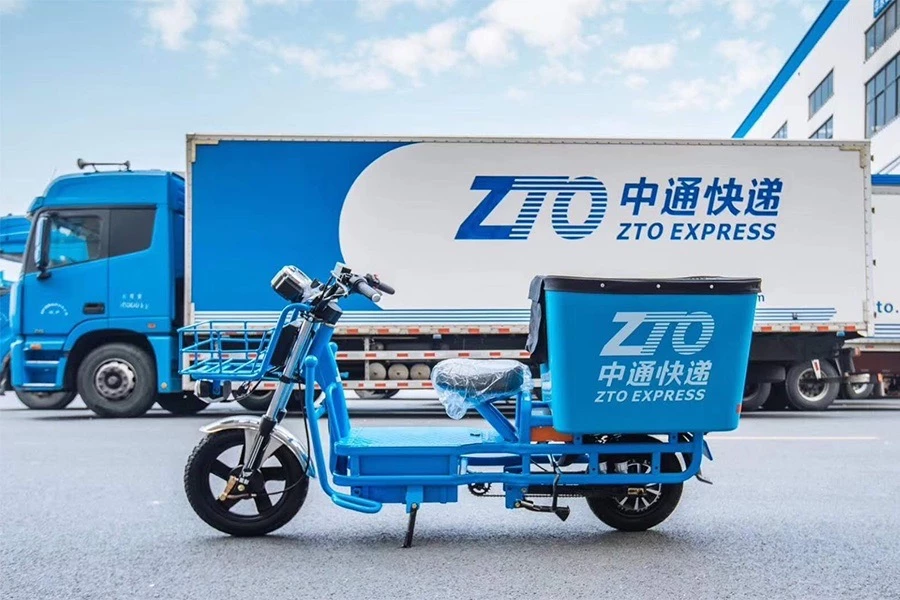

The logistics provider’s market share fell as its parcel volume growth trailed the industry last year, signaling its profit-oriented development strategy was facing headwinds
Key Takeaways:
- ZTO’s parcel volume increased 12.6% last year to 34 billion units, slower than the industry growth rate
- The logistics company’s market share dropped from 22.9% in 2023 to 19.4% last year, falling below the 20% mark for the first time since 2020
Weakening household consumption in China has yet to dent the country’s love affair with e-commerce, as a broader trend of ever-smaller packages drives the latest growth wave. Such a move towards “good things in small packages” has charged up the industry, at least in terms of parcels delivered. That was true in 2024 for industry leader ZTO Express (Cayman) Inc. (2057.HK; ZTO.US), whose latest annual results show it recorded yet another bumper year.
The results show ZTO’s revenue rose 15.3% year-on-year in 2024 to 44.3 billion yuan ($6.12 billion), while its profit increased 0.8% to 8.82 billion yuan.
Data from China’s State Post Bureau shows a massive 174.5 billion packages were delivered nationwide last year, up 21% year-on-year, accelerating from the 19.4% growth in 2023. But the industry’s total revenue grew just 13% to 1.4 trillion yuan, slowing from the 14.5% growth in 2023.
While ZTO’s revenue growth slightly outperformed the broader industry, the growth of its parcel volume showed signs of slowing. Last year the company’s volume of parcels delivered totaled 34 billion units, up 12.6% year-on-year. While that was enough to make the company the industry’s largest courier by parcel volume for a ninth consecutive year, its volume growth was well behind the industry average of 21%. As a result, ZTO’s market share dropped from 22.9% in 2023 to 19.42% in 2024, falling below the 20% mark for the first time since 2020.
China’s delivery rankings based on parcel volume were roughly the same in 2024 as 2023. ZTO led the way, followed by runner-up YTO Express (600233.SH), which delivered around 26.6 billion parcels for the year. Yunda (002120.SZ) was third at 23.8 billion units, followed by STO Express (002468.SZ) with 22.7 billion, J&T Express (1519.HK) with 19.8 billion, and S.F. Holding (6936.HK; 002352.SZ) with 13.3 billion.
While retaining its crown in terms of parcels delivered, ZTO’s 12.6% volume growth was well behind its rivals, all of which grew by at least twice that rate. STO Express, J&T Express and Yunda achieved growth of 29.83%, 29.1%, and 26.14%, respectively, last year, while YTO Express grew by a similarly strong 25.33%.
Holding on to market share is key to surviving in such a sector where rivals typically lack much differentiation. That means ZTO is likely feeling some pressure to maintain its lead as its rivals nip at its heels.
Smaller packages
The rapid rise of new-generation of bargain-oriented e-commerce platforms such as Pinduoduo, Douyin and Kuaishou is fueling a flood of deliveries for low-value packages, driving the trend of ever-smaller packages that often contain just single, small item. As the packages have gotten smaller, so have the prices for delivering them. Industry data shows the average delivery price fell from 9.1 yuan in 2023 to 8 yuan last year, eroding profit margins for delivery companies.
The package miniaturization trend is behind the rapid growth in parcel deliveries for companies like YTO Express, STO Express, J&T Express and Yunda, which focus on low delivery prices as a key selling point. By comparison, ZTO was more focused on delivering more high-value parcels in 2024.
Last year the company listed “accelerating profit growth” as a business priority as it tried to extricate itself from the ongoing price wars that are a constant feature in the ultra-competitive sector. So, while its peers were busy cutting prices, ZTO’s price per unit actually rose 2.7%, and its average transportation cost dropped 8.9%. That translated into a 17.6% rise in its gross profit to 13.72 billion yuan, and gross margin growth from 30.4% in 2023 to 31% last year.
The bottom line was ZTO sacrificed some market share in exchange for better profits. But was it worth it?
Founder and Chairman Lai Meisong said a top priority this year will be to exceed the industry-average growth rate for its parcel volume. The company is targeting a volume of between 40.8 billion and 42.2 billion parcel deliveries for the year, representing 20% to 24% growth, showing ZTO isn’t ready to give up more market share in pursuit of better profits just yet.
Betting on retail market
ZTO has been shifting its focus to the higher end of the market lately with a focus on retail parcel deliveries, which are more profitable than higher-volume bulk deliveries. Retail parcels refer to parcels sent by individuals or non-e-commerce vendors, as well as e-commerce returns.
ZTO’s average daily volume for such retail parcels in the fourth quarter of last year exceeded 7 million units, up nearly 50% year-on-year from 2023, much faster than the volume growth of all of its e-commerce parcel deliveries. The volume of e-commerce returns grew even faster, roughly doubling.
Lai said that of the 7 million retail parcels ZTO delivers on an average day, 3 million come from individuals and 4 million are returned e-commerce items. He said he sees expanding the retail parcel business as key to improving the company’s revenue structure, and believes consumers are motivated by ZTO’s value-preposition associated with online purchases.
Hive Box Holdings, the express delivery locker operator, projected the volume of e-commerce return parcels will grow at an annual rate of 20.7% between 2023 and 2028, rising from around 3.6 billion units in 2019 to 8.2 billion in 2023 and further to 20.9 billion in 2028, according to its previous filing to Hong Kong’s stock exchange in preparation for an IPO.
The 2023 figure of 8.2 billion returned parcels translates to approximately 20 million daily returns, rising to 57 million by 2028. As such returns grow, they could become a major growth driver for ZTO and its peers in the future.
Valuation-wise, ZTO currently trades at a price-to-earnings (P/E) ratio of 13.6 times, higher than the 11 for YTO Express but lower than STO Express’ 25 times and S.F. Holding’s 18.5 times. That shows it’s valued in the middle-to-lower range among its peers, implying some upside potential.
That said, investors need to ask certain questions, including whether parcel deliveries will continue to post strong growth in defiance of China’s slowing economy. Will ZTO’s bet on the retail parcel market pan out? And how will it manage the balance between parcel volume and profit margin? Answers to such questions will be key to how the company fares in this fast-moving and ultra-competitive industry.
© 2025 Benzinga.com. Benzinga does not provide investment advice. All rights reserved.

